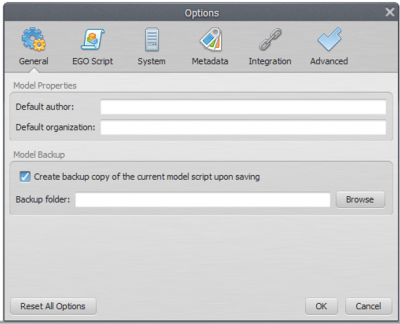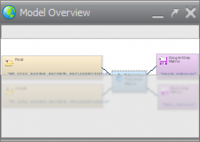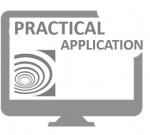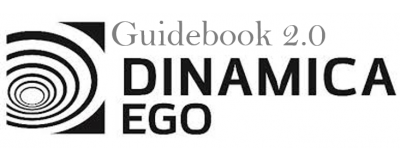This is an old revision of the document!
LESSON 1: Exploring the Dinamica EGO Graphical Interface
When Dinamica EGO starts, you are presented with the graphical interface as shown in the figure.
These five components of the Dinamica EGO interface are described in more detail in the following sections:
1. Menu Bar
The Menu bar is the graphical control element which contains drop-down menus. The menu bar provides access to various Dinamica EGO features using a standard hierarchical menu. The top-level menus and a summary of some of the menu options are listed below, together with the associated icons.
The icons on the menu bar are shortcuts to create, open, save a model, save model to a new file, work with model wizards, check model script operator integrity, check model script connection integrity, run a model, open the map viewer and work with submodels:

A new option window is available to enter model information and to set Dinamica EGO environment parameters. Go to Main menu Tools – Options:

The option window is divided into 4 tabs. The first tab is for filling in information on the model, setting message log, model backup, and appearance. The second is about settings of script writing , the “system” tab includes new versions update options and number of model scripts available options. And the last tab is for advanced options where raster map swapping can be disabled and you can define the number of processors to be used.
2. Library
In the library window you will find the available functors and submodels organized in subsets according to their nature and application.
3. Sketch
The sketch toolset permits delect seletions, grouping options, execute layout, organizing of the model layout, and exhibiting the model layout in different zooms
The sketch toolset permits delect seletions, grouping options, execute layout, organizing of the model layout, and exhibiting the model layout in different zoom:

4. Model Overview
The Model Overview provides a synoptic view of the model and is especially useful for large models that do not fit entirely on the sketch when shown at the default size. The shaded area on the bird view corresponds to the sketch window. Move the shade to zoom at a particular part of the model. The tree view provides a hierarchical view of the model allowing one to select or locate a functor and subsequently to edit its properties through the functor property window.

_______________________________________________________________________________________________________________________
5. Model Issues / Message Log / Documentation / Explorer
The message log window is a space reserved for reporting textual messages showing results, errors, warnings, information and debug information. By default, the log text will output all information, but the user can change this just by pressing the button for the desired information level.
- You can change the interface layout by dragging interface panels to new locations. The modified interface layout is automatically saved and reused next time Dinamica EGO is open. It is possible to restore the interface component layout to its original configuration clicking on Window
- You can resize or close windows. This may become useful as the model increases in number of functors. You just need to increase the sketch size at the expense of the other windows » Reset Window Layout.
_______________________________________________________________________________________________________________________
Models on Dinamica EGO
Models are expressed in Dinamica EGO as a sequence of functors connected via compatible inputs and outputs. Hence data flow through these operators to produce a desirable outcome that represents the solution to a query on some environmental topic.
_______________________________________________________________________________________________________________________
Functor action bar
In the functor action bar you will find tools that allows connecting, editing, inspecting, selecting, moving functors, editing the functor ports, writing comments to a functor and organizing of the model layout:

RUN THE DINAMICA EGO AND EXPLORATE ITS GRAPHICAL INTERFACE. DRAG FUNCTORS TO SKETCH, COMMENT ON THEM. GET TO KNOW THE ITEMS IN THE LIBRARY.



